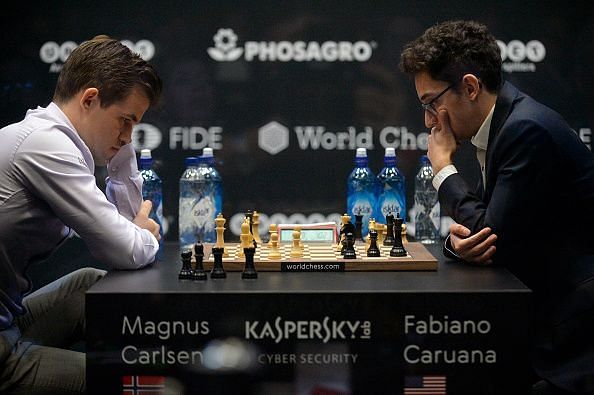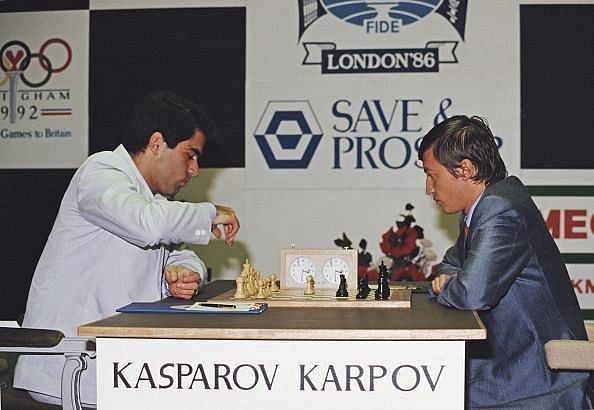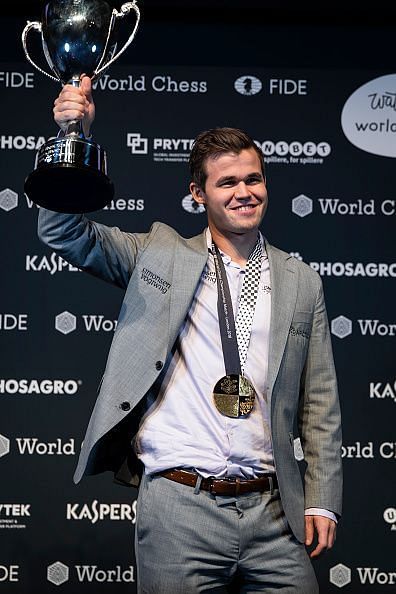
World Chess Championship 2018: Carlsen defends his crown in rapid tie-breaks

Chess doesn't receive much space in the mainstream media and consequently, a very large section of the people rarely get to know about the big events in chess. Therefore, if you didn't know that the biggest event in professional chess concluded yesterday, it is understandable.
The World Chess Championship 2018, a match comprising of 12 classical chess games, featuring the defending World Chess Champion Magnus Carlsen (Norway) and the challenger Fabiano Caruana (USA) concluded in London yesterday, and Magnus Carlsen won the match after comprehensively blowing away the challenge from Fabiano Caruana in the Rapid tie-breaks.
If you are not a chess follower then a few of the words in this paragraph would have seemed alien to you. For instance, the difference between a classical game and rapid tie-break.
Much like cricket, chess is played in the three formats, and they differ from each other on the basis of how much time it takes to complete one game of chess.
The classical format is the longest form of chess and can be equated to the cricket's version of a Test Match. In the classical game, each player starts with 1 hour & 40 minutes in which they have to play the first 40 moves of the match. Additionally, when they hit the clock to indicate it is the opponent's turn to move, they get an increment of 30 seconds for making each move.
Upon the completion of 40 moves, the players get another 50 minutes in addition to whatever time is left on their clock at that point and on reaching move number 60, they get another 15 minutes in addition to whatever time is left on the clock for the rest of the game.
That is a lot of time for each player to assess the situation calmly and carefully, plan his moves, re-assess and ensure that they are not missing something, calculate deep and complex lines - for the next 10 or 15 moves - and then make the move. There is no rush in classical chess.
Classical games have been known to last up to 7 hours.
Then there is rapid chess - in which each player starts with only 25 minutes on the clock (15 in some rapid competitions), and for each move, they get 10 seconds extra on the clock, or increment, as it is known in the chess world.
Additionally, what they start with is all the time they have to play the entire match in, regardless of whether they get to move number 40 or not, they get no extra time during the match.
Therefore in a rapid chess match, the players have to play very (surprise) rapidly (duh) and can't take too long to calculate as precisely as they could in a classical game. In a classical game, it is not uncommon for a player to go into a 30-minute-think on their turn to move. If he did that in a Rapid game, the player would lose as he would run out of time.
Therefore in a rapid game, the play is not the most precise and at times players have to rely on instinct rather than stone cold calculation because they don't have enough time. A rapid game can be equated to a One Day International in cricket. It is not quite long as a test match, but definitely not as breakneck as T20 cricket.
Lastly there is blitz chess where players start with only 5 minutes on their clock and get 2 seconds increments for every move. Blitz chess much like T20 cricket is the most exciting to watch as everything is happening at great speed and players are quickly making moves and calculating on the fly.
Now returning to the topic of the World Championship match, which is the biggest event in chess and by a mile, the most coveted title in professional chess.
Chess is a very balanced game and while white starts with a slight edge as he is the first mover, if played accurately black shouldn't lose.
It is only if black misses a move or makes slightly inaccurate moves then does white usually get a big enough edge to win the match.
A very sweeping statement to make about chess would be that usually white is the attacker looking to checkmate black and black is the defender looking to ensure that white doesn't succeed.
This is not true of all games and indeed there are a plethora of games at top level professional chess where black has seized the initiative and done most of the attacking in the match and white has done most of the defending.
However, overall, the game of chess is very balanced, and if you make all the most precise and correct moves in the position and if your opponent does the same, then neither should lose.
Since at the top level in professional classical chess, all the players are very good at calculating the moves, understanding the strategy, comprehend what their opponent is trying to do, formulate a plan and they have plenty of time to do all this in, they usually find the perfect or near perfect move each turn and as a result a very large number of classical chess games end in a draw.
Going by the trend in the previous decade in classical chess, between two top-level opponents, a draw is the default result and either player winning is an aberration.
This is where it leads to an issue in the 12 classical games of a World Championship match.
Historically Chess World Championship matches had no limit on the number of games that would be played. The match continued until one player won 6 games and he was declared the winner of the match.
All this changed after the 1984 World Championship, played between Anatoly Karpov and Gary Kasparov. Karpov was the World Champion going into this match and whoever won 6 games first, would win the match.

However, even after 47 games, neither player had reached 6 wins. Karpov, at this point, led the match with 5 wins and Kasparov had 3 wins to his name, while all the rest of the games had finished in draws.
At this point, FIDE president called off the match fearing for the health of the players who had both lost considerable weight during this never-ending match.
There was a rematch in 1985 and this time the number of games was limited to 24. If at the end of 24 games the match was still tied, then the reigning world champion would retain his title. Today the Chess World Championship is limited to 12 classical games.
Kasparov won the match over 24 games and became world champion, perhaps the most formidable one in history, and would go onto defend his title multiple times over the next decade.
However, the point of this background was to show that earlier World Championship matches couldn't possibly end in a draw. Whoever won 6 games first became the champion and till that point, the match continued.
With a cap on the number of games, it was possible for World Championship matches to finish in a tie and it was argued that if the defending champion retained his title in the event of a drawn match then the challenger was effectively starting with a score of -1 (i.e., he had lost a game even before the match got underway).
This was deemed too big an advantage for the defending champion and therefore tie-breaks were introduced.
If the match finished in a tie, then the players would play 4 rapid games and whoever won over the course of those four games would win the tiebreak. Rapid chess games tend to finish in draws a lot less frequently since the players don't have the time on the clock to find the perfect move every turn and need to rely on their instincts and that is where mistakes creep in and one player ends up losing.
However even though Classical and Rapid chess seem similar they are really two very distinct forms of chess, much like how test cricket and ODI cricket are two very distinct forms of the same sport. This is evidenced by the fact that there are many players who are great at playing rapid chess but not as good at classical chess and vice versa.
Deciding the classical world championship via rapid tie-breaks is like if the Ranji Trophy final finished in a draw, then the teams play an ODI the following day to decide who wins the Ranji Trophy, or if a test series finishes in a draw then the teams play an ODI to decide who won the test series, or if a FIFA World Cup knockout game ends in a draw, then deciding the outcome the match on the basis of a Futsal match.
The previous two World Championships have finished tied after 12 games and on both occasions, Magnus Carlsen has retained his title in Rapid tie-breaks, as he is a top rapid player as well and his opponents on the two occasions haven't been so.

This has seemed particularly cruel to both his challengers, as despite matching Magnus Carlsen move for move over 12 classical games, the two challengers lost in rapid chess, which the match isn't about. It is the classical chess championship and rapid chess should have absolutely no influence over who wins the classical world championship match.
Think if India travelled to South Africa and drew the test series and then an ODI series was used as a tie-break, which India lose and therefore South Africa are declared the winners of the test series... because they won the ODI tie-break. Wouldn't that be absurd?
Well that is in a way what has happened in the last two world championship matches. The problem is that there are seemingly no great solutions to the problem of tied World Championships in chess and a rapid playoff (despite its seeming absurdity) at least ensures a finality to proceedings.
The alternative would be a World Championship where the match continues till one player wins a pre-agreed X no. of games, but that could lead to a never-ending World Championship with most games ending in draws like in the 1984 World Chess Championship.
Alternatively, chess could go back to the rule that if the match finishes in a tie then the incumbent world champion would retain the title, but that puts a big handicap on the challenger as he would effectively start with a defeat right from the start and it wouldn't be a fair match.
There is no acceptable solution to this conundrum in chess right now. One of the alternate methods that have been suggested by the chess community is to allow the challenger an extra game with white pieces in the match.
So the defending champion would play 5 games with white pieces and 7 games with the black pieces, but now if the match finished in a draw then the defending champion would retain his title.
This still gives the challenger the handicap of effectively starting the match -1, but it is argued that the extra game with white is more than enough to even out this handicap and make it a fair contest.
The other side of that argument is that an extra with the white pieces for the challenger, does more than only 'balance' the match, and rather tilts the balance in the favor of the challenger a little too much.
Chess has to sort out these issues and find a more balanced tie-break for the tied World Championship matches. Till then players like Caruana will keep getting a little hard done by the tie break rules.
Of course, this is not to say Magnus Carlsen didn't deserve to win and the result in the rapid tie-break was a very comprehensive reply to all his critics, and additionally, he didn't make the rules for the tie-break and they are what they are for both players.
However, there is a need for chess to look at a better alternative, as it seems fundamentally flawed that a player playing for the World Chess Championship in best-of-12 classical games, goes toe to toe with the World Champion and finishes the match tied, but is then robbed because his rapid play is not as good.
When the match is in the classical format, why should rapid chess have any influence on the outcome of that match. It is a problem worth sorting out and a better alternative to rapid tie-breaks is required in chess.